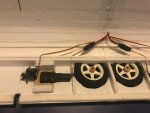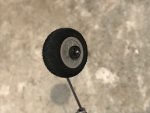Main retracts are in.
Ok, the main retracts are now in, working, and they fully retract recessed into the wing.
This has been a bit of an adventure with a lot of head scratching and false starts.
I started with the PZ-15094 servoless retracts and the struts/wheels from the RocHobby Staggering. Unfortunately the tire was too thick, so I changed the wheel to the Du-Bro 2.5" Micro Sport Wheel. It turns out that 2.5" diameter is exactly the scale size of the wheels on the Staggerwing, though I had to give up on the wheel pants.
I created some wheel bushings using extra plastic that came from a pack of control horns (for the inner bushing) and a chunk of paint stirrer stick (for the outer bushing). I used the original snap-ring that came on the RocHobby struts to hold it all together.
Ideally (for the next person building this plane), we could find this 3mm wheel strut without having to waste money on the RocHobby wheels and wheel pants that don't work with this plane. Anyone know where to find these struts by themselves?


After a days of test-fitting in the wing, I finally settled on building a wood mount for the retracts out of a mix of 3/32" and 1/16" hobby plywood, screwing the retract unit in from the bottom to give myself a little more room in the wing (it's a tight fit in there). The main support that is inside the wing is 3/32" plywood and the pieces that stick down to form the retract mount is made of 1 piece of 1/16" and 1 pieces of 3/32" plywood. It's all hot-glued together, glued into the wing, with extra glue around the edges inside. I'm temporarily mounting the retracts with extra servo screws, but the final (longer) screws will go through all 3 pieces of wood.




Here they are in action:
Next step is to install the flap servos and then add reinforcements in the wing to make up for the cuts (especially to the spar) and add foam to connect the wood retract mounts to the upper wing for extra support.
Ok, the main retracts are now in, working, and they fully retract recessed into the wing.
This has been a bit of an adventure with a lot of head scratching and false starts.
I started with the PZ-15094 servoless retracts and the struts/wheels from the RocHobby Staggering. Unfortunately the tire was too thick, so I changed the wheel to the Du-Bro 2.5" Micro Sport Wheel. It turns out that 2.5" diameter is exactly the scale size of the wheels on the Staggerwing, though I had to give up on the wheel pants.
I created some wheel bushings using extra plastic that came from a pack of control horns (for the inner bushing) and a chunk of paint stirrer stick (for the outer bushing). I used the original snap-ring that came on the RocHobby struts to hold it all together.
Ideally (for the next person building this plane), we could find this 3mm wheel strut without having to waste money on the RocHobby wheels and wheel pants that don't work with this plane. Anyone know where to find these struts by themselves?


After a days of test-fitting in the wing, I finally settled on building a wood mount for the retracts out of a mix of 3/32" and 1/16" hobby plywood, screwing the retract unit in from the bottom to give myself a little more room in the wing (it's a tight fit in there). The main support that is inside the wing is 3/32" plywood and the pieces that stick down to form the retract mount is made of 1 piece of 1/16" and 1 pieces of 3/32" plywood. It's all hot-glued together, glued into the wing, with extra glue around the edges inside. I'm temporarily mounting the retracts with extra servo screws, but the final (longer) screws will go through all 3 pieces of wood.




Here they are in action:
Next step is to install the flap servos and then add reinforcements in the wing to make up for the cuts (especially to the spar) and add foam to connect the wood retract mounts to the upper wing for extra support.
Last edited:






















































